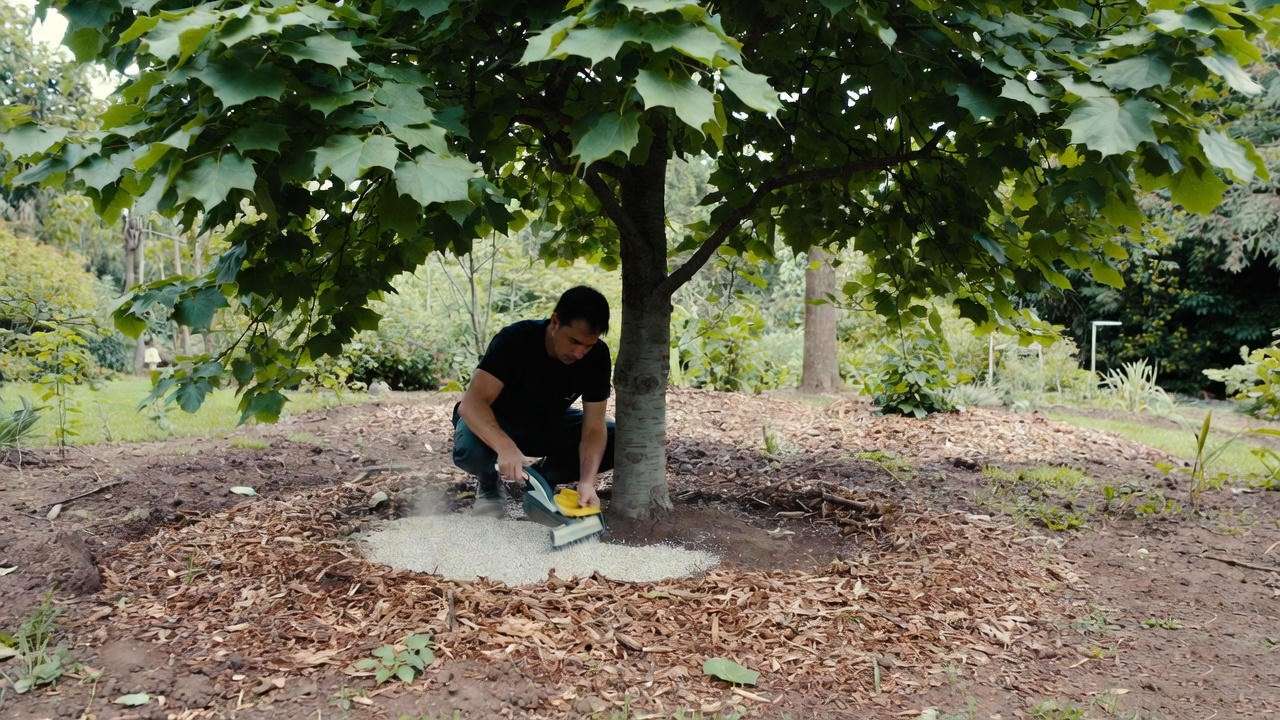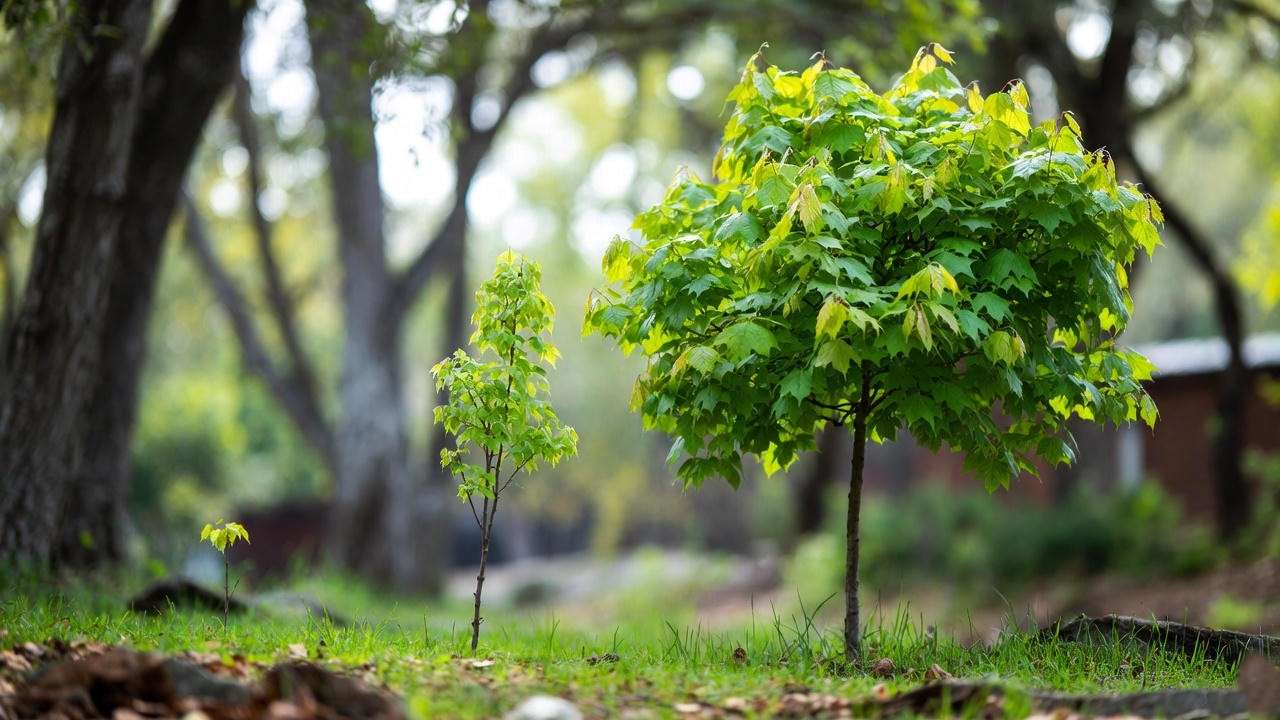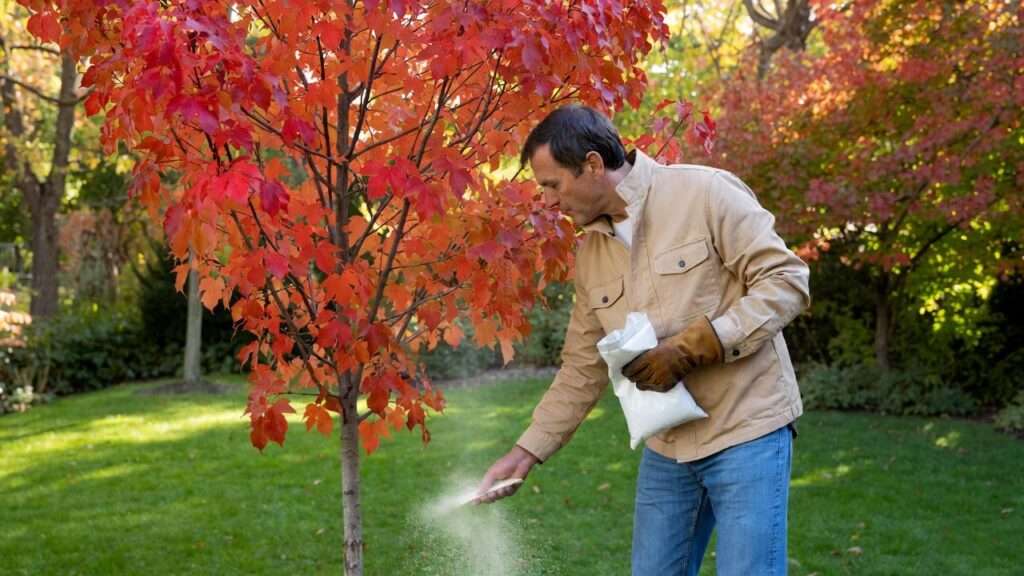There’s nothing quite like the breathtaking sight of a healthy maple tree exploding with vibrant spring growth or blazing autumn color. But here’s a secret many homeowners don’t realize: the way you fertilize a maple tree can dramatically influence its growth, leaf quality, and long-term health. In fact, improper fertilization is one of the top reasons maples struggle, lose vigor, or fail to develop the color they’re known for. That’s why learning how to fertilize a maple tree correctly isn’t just helpful — it’s essential.
Whether you have a majestic sugar maple, a delicate Japanese maple, or a fast-growing silver maple, the right fertilization approach can be the difference between a thriving tree and one that slowly declines. This expert guide breaks down everything you need to know: when to fertilize, which products to use, how much to apply, and mistakes to avoid. Let’s dive in. 🌿
Understanding the Nutritional Needs of Maple Trees 🍂
Before you add anything to the soil, you need to understand what a maple tree actually needs — and what it doesn’t.
How Maple Trees Naturally Get Their Nutrients
Maples evolved to thrive in forest ecosystems. In nature, they receive nutrients from:
- Decomposing leaves and organic debris
- Fungal networks (mycorrhizae) that help roots absorb nutrients
- Moist, aerated soil rich in microbial activity
- Slow-release nitrogen from natural sources
In a home landscape, however, these natural systems are often disrupted. We rake leaves, compact soil, or grow grass that competes for nutrients. That’s where smart fertilization comes in.

Why Supplemental Fertilizing Is Sometimes Necessary
Fertilizing may be needed when:
- Soil is nutrient-poor or sandy
- Grass or other plants compete heavily with tree roots
- Trees show signs of stress
- Landscaping changes alter soil structure
- Maples grow in containers
- Rapid canopy development is desired
A soil test will reveal exactly which nutrients your tree lacks — more on that shortly.
Identifying Signs of Nutrient Deficiency
Common symptoms include:
🍁 Pale or yellowing leaves (chlorosis)
🍁 Stunted or slower growth
🍁 Early fall color changes
🍁 Sparse or thinning canopy
🍁 Shorter annual branch growth
If your tree shows more than one of these signs, fertilization may help.
The Best Time to Fertilize a Maple Tree ⏰
Timing is everything. Applying fertilizer at the wrong time can damage the tree or encourage weak growth.
Ideal Fertilization Seasons (Spring vs. Fall)
🌸 SPRING (Primary Window)
Best time for most maples. Trees are actively growing, making nutrient uptake efficient.
🍂 FALL (Secondary Window)
Use with caution. Only apply slow-release or organic fertilizers, as fast-acting formulas can trigger tender growth before winter.
When Not to Fertilize
Avoid fertilizing when:
🚫 The tree is newly transplanted
🚫 There’s drought or extreme heat
🚫 The soil is waterlogged
🚫 The tree is severely stressed from disease or pests
🚫 Late summer — this can force new growth that winter will kill

Timing Based on Maple Tree Type
Different maples have different needs:
- Red Maple: Benefits from modest feeding, prefers slightly acidic soil
- Sugar Maple: Sensitive to salt and overfertilization
- Japanese Maple: Requires gentle, low-nitrogen fertilizers
- Silver Maple: Fast-growing and nutrient-hungry, but easy to overfeed
Choosing the Right Fertilizer for Maple Trees 🌿
Using the wrong fertilizer is one of the most common — and most harmful — mistakes homeowners make.
Recommended NPK Ratios for Maples
Maples prefer balanced or low-nitrogen fertilizers, such as:
- 10-10-10
- 5-5-5
- 4-3-4
- 12-4-8 (for fast-growing species like silver maples)
High-nitrogen fertilizers (like lawn food) can scorch maple roots and cause weak, floppy growth.
Organic vs. Synthetic Fertilizers
Organic Options:
✔ Compost
✔ Aged manure
✔ Fish emulsion
✔ Bone meal
✔ Worm castings
✔ Biochar blends
Benefits:
- Reduces risk of burn
- Improves soil structure
- Supports microbiome
- Provides slow, steady release
Synthetic Options:
✔ Granular slow-release formulas
✔ Tree spikes (use cautiously)
✔ Water-soluble fertilizers for potted maples
Benefits:
- More predictable nutrient release
- Faster results
- Easy to measure

Soil Testing: The Most Important Step Most Homeowners Skip
A soil test reveals:
- pH
- Nitrogen levels
- Phosphorus levels
- Potassium levels
- Organic matter content
- Micronutrient deficiencies
You can use:
- DIY kits (quick estimates)
- County extension or lab tests (high accuracy)
Without a soil test, fertilizing is guesswork.
How to Fertilize a Maple Tree Step-by-Step 🧰
This is where precision matters. Correct application ensures your tree gets what it needs without harm.
Step 1 — Measure the Dripline
The dripline is the circle beneath the outermost branches.
This is where feeder roots live — and where fertilizer should be applied.
Step 2 — Calculate the Correct Amount
General rule:
Use 1–3 pounds of actual nitrogen per 1,000 square feet of root zone, depending on tree size and soil quality.
Young maples need less.
Large maples may need more — but only once per year.
Step 3 — Apply Fertilizer Properly
There are several safe techniques:
Broadcast Method (Most Common)
Sprinkle fertilizer evenly across the root zone.
Avoid direct contact with trunk bark.
Deep-Root Feeding
Useful for compacted soil. Requires a soil auger or professional injection tool.
Slow-Release Granules
Ideal for long-term feeding and preventing burn.
Step 4 — Water After Fertilization
Water helps fertilizer dissolve and reach feeder roots.
Aim for moist (not soaked) soil.
Step 5 — Monitor the Tree’s Response
Watch for:
- Greener leaves
- Increased growth
- Fuller canopy
- Improved fall color
If leaves turn brown or curl, you may have overfertilized.

Special Fertilizing Considerations by Maple Tree Age 🌱➡️🌳
How to Fertilize Newly Planted Maples
Don’t add fertilizer during the first year.
The priority is root establishment, not leaf growth.
Fertilizing Young/Developing Maples
Use:
- Light applications
- Low-nitrogen, slow-release formulas
- Organic compost around the dripline
Fertilizing Mature or Established Maples
These trees may not need annual fertilization unless deficient.
Focus on soil health rather than nutrients.
Fertilizing Potted or Container-Grown Maples
Japanese maples especially require:
- Monthly light feeding during spring/summer
- Specialized acidic or bonsai fertilizers
- Avoiding salt buildup by flushing soil periodically

How Soil Type Affects Fertilization Needs 🧪
Soil is the foundation of a maple tree’s health. Even the best fertilizer can’t compensate for poorly structured, compacted, or imbalanced soil. Understanding your soil type helps you tailor fertilization for maximum benefit without waste or harm.
Clay Soil
Clay soil holds nutrients well but often suffers from:
- Poor drainage
- Compaction
- Limited oxygen flow to roots
Fertilization tips for clay soil:
- Use slow-release fertilizers to prevent nutrient overload
- Add organic matter annually to improve texture
- Avoid heavy applications of nitrogen, which can cause shallow rooting
- Ensure good mulching to reduce surface cracking
Maples planted in clay soil especially benefit from aeration around the dripline.
Sandy Soil
Sandy soil drains quickly and loses nutrients fast. This means:
- More frequent but lighter fertilization
- Increased need for organic matter
- Higher risk of nutrient leaching
Fertilization tips for sandy soil:
- Apply compost or leaf mold twice a year
- Choose slow-release nitrogen formulas
- Add mulch to retain moisture
- Consider a drip irrigation system for consistent hydration
Maples in sandy soil rarely thrive without supplemental nutrition.
Loamy Soil
Loam is the gold standard for tree health: well-draining, nutrient-rich, and easy to work with.
Fertilization tips for loamy soil:
- Moderate feeding once per year is usually enough
- Soil tests help fine-tune micronutrient needs
- Maintain a 2–4 inch layer of organic mulch
Most maples flourish with minimal intervention in loamy soil.
Acidic vs. Alkaline Conditions
pH dramatically influences nutrient uptake. For example:
- Iron becomes unavailable in alkaline soils
- Nitrogen uptake struggles in acidic soils
- Maples prefer a pH of 5.5 to 7.3, depending on species
If your soil is too alkaline:
- Add elemental sulfur
- Use acidic organic matter like pine needles
- Choose fertilizers formulated for acid-loving plants (especially for Japanese maples)
If your soil is too acidic:
- Apply garden lime
- Use balanced compost rather than acidic mulch
Correcting pH often resolves leaf chlorosis without any fertilizer at all.
Common Mistakes to Avoid When Fertilizing Maple Trees ⚠️
Even well-intentioned gardeners can harm their maples by applying the wrong products, the wrong amount, or at the wrong time. Avoid these pitfalls to protect your tree’s health.
Overfertilizing (Burn Risk & Weak Growth)
Too much nitrogen can:
- Burn roots
- Cause rapid, weak branch growth
- Increase susceptibility to pests
- Reduce fall color intensity
- Lead to shallow rooting
Slow-release formulas greatly reduce these risks.
Fertilizing at the Wrong Time
Applying fertilizer:
- In late summer encourages frost-prone new growth
- During drought adds stress
- Right after planting disrupts root development
Always follow your region’s seasonal cycle.
Using the Wrong Product
Common mistakes include:
- Using lawn fertilizer near maples
- Applying high-nitrogen fertilizers
- Using fast-release formulas on Japanese maples
- Adding fertilizer to trees in poor soil without fixing the soil first
Maples respond best to gentle, balanced nutrition.
Ignoring Soil Compaction or Mulch Issues
Compacted soil suffocates roots.
Mulch volcanoes suffocate trunks.
Before reaching for fertilizer, evaluate soil structure and mulching practices. Sometimes improving aeration or removing excess mulch is all a maple needs.
Additional Tips for Keeping Maple Trees Healthy 🌟
Once your fertilization routine is dialed in, a few extra practices can elevate your maple’s health and appearance even further.
Proper Watering Techniques
Maples prefer consistent moisture — not soggy soil.
Water deeply:
- Once per week during dry seasons
- More frequently for sandy soil
- Less for clay-rich soil
Drip irrigation systems are excellent for maintaining even moisture levels.
Mulching Best Practices
Mulch protects roots, conserves water, and enriches soil. Follow these guidelines:
- Apply 2–4 inches of mulch
- Keep mulch 6 inches away from the trunk
- Use organic materials like shredded bark, leaves, or compost
Mulching too heavily can cause rot and pest problems.
Preventing Pests and Diseases Through Proper Nutrition
Well-fed maples resist:
- Aphids
- Borers
- Anthracnose
- Tar spot
- Powdery mildew
Balanced nutrition strengthens the tree’s natural defense systems.
Encouraging Brighter Fall Foliage With Balanced Nutrition
Fall color depends on:
- Proper nitrogen balance
- Good soil moisture
- Adequate sunlight
- Stress-free growing conditions
Trees that receive too much nitrogen often produce duller leaves in autumn.
Real Examples: What Happens When You Fertilize Correctly vs. Incorrectly 📸
Learning from real-world outcomes brings the science to life.
Case Study: Underfertilized Maple
Symptoms:
- Sparse canopy
- Pale leaves
- Reduced annual twig growth
Once given a balanced slow-release fertilizer and organic mulch, canopy density improved within one growing season.
Case Study: Overfertilized Maple
Symptoms:
- Leaf scorch
- Excessive, floppy twig growth
- Increased pest activity
- Smaller root system
Tree required flushing with water and removal of all fast-release fertilizers.
Case Study: Perfectly Balanced Fertilization Schedule
Results:
- Deep green leaves
- Strong annual growth
- Vivid fall color
- Balanced soil pH and nutrient levels
These trees also demonstrated increased resistance to drought stress.
Expert Recommendations for Annual Maple Care 📘
A professional-level care plan ensures long-term success.
Yearly Fertilization Calendar
Early Spring:
- Soil test
- Apply slow-release fertilizer
- Add compost
Mid-Summer:
- Inspect for pests
- Water deeply during dry spells
Early Fall:
- Add mulch
- Optional: apply organic fertilizer only
Maintenance Checklist
✔ Check for girdling roots
✔ Inspect leaves for color changes
✔ Test soil every 2–3 years
✔ Refresh mulch annually
✔ Prune only in late winter or mid-summer to avoid sap bleed
When to Seek an Arborist
Call a professional if your maple shows:
- Severe leaf decline
- Bark cracks or oozing
- Unusual canopy dieback
- Soil heaving
- Fungal growth near the base
Early intervention can save a declining tree.
Frequently Asked Questions About Fertilizing a Maple Tree ❓
How often should you fertilize a maple tree?
Once per year is usually enough unless soil tests indicate deficiencies.
Is Miracle-Gro good for maples?
It can be used sparingly, but slow-release, balanced fertilizers are better for long-term health.
Should you fertilize a maple in the fall?
Only with organic or slow-release formulas. Avoid high-nitrogen products.
What is the best fertilizer for Japanese maples?
Low-nitrogen, acid-forming fertilizers work best (e.g., 4-3-4 organic blends).
Can fertilizing help a stressed maple tree?
Yes, but only if stress is nutrient-related. Fix soil compaction, watering issues, or pests first.
Conclusion: Keep Your Maple Trees Thriving for Years 🍁
When you fertilize a maple tree correctly, you unlock its full potential — lush growth, vibrant color, strong roots, and decades of shade and beauty. Thoughtful fertilization isn’t just a chore; it’s a long-term investment in your landscape. Whether you’re caring for a stately sugar maple or a delicate Japanese maple, the combination of proper timing, balanced nutrients, healthy soil, and consistent care ensures your tree will flourish for generations.













